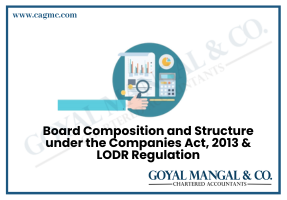 Every entrepreneur looks forward to the first step in beginning a business, which is establishing a legal identity by registering a company. Also, companies are in charge of legal documents that outline the dos and don’ts of doing business. Memorandum of Association (MOA) and Articles of Association (AOA), sometimes known as company charters, outline a firm’s scope of operation and internal management. It is one of the most important procedures in the formation of a Private Limited Company for the preparation of these documents. As a result, drafting them necessitates extreme precision and clarity. Let’s take a look at what articles of association and memorandums of association mean and its further details.
Every entrepreneur looks forward to the first step in beginning a business, which is establishing a legal identity by registering a company. Also, companies are in charge of legal documents that outline the dos and don’ts of doing business. Memorandum of Association (MOA) and Articles of Association (AOA), sometimes known as company charters, outline a firm’s scope of operation and internal management. It is one of the most important procedures in the formation of a Private Limited Company for the preparation of these documents. As a result, drafting them necessitates extreme precision and clarity. Let’s take a look at what articles of association and memorandums of association mean and its further details.
| Table of contents |
Meaning of MOA and AOA under Companies Act 2013
The Memorandum of Association (MOA) is a document that provides all of the necessary information for the formation of a business. Whereas, the Articles of Association (AOA) is a document that contains all of the rules and regulations of the company. Likewise, The Memorandum of Association (MOA) and Articles of Association (AOA) establish the scope of operations, goals, norms, and internal administration of a corporation.
When you want to establish your firm as a separate entity and register it as a Private or Public limited Company, or if you want to incorporate it, you’ll need to fill out a Memorandum of Association (MOA) and Articles of Association (AOA).
Memorandum of Association under Companies Act 2013
On the contrary, company relationship with its shareholders explains as the Memorandum of Association (MOA). Also, it is a company’s most significant document because it states the company’s goals. It also covers the company’s abilities and the areas in which it can act. As per Section 2 (56) of Companies Act, 2013“memorandum means the memorandum of association of a company as originally framed or as altered from time to time in pursuance of any previous company law or of this Act”
Various contents of the Memorandum of Association (MOA)
On the contrary, there are six clauses under the memorandum of the association spell out below briefly:
Name Clause
The Company’s name is its first and most distinctive identifier. As a result, the memorandum’s name clause contains the company’s real, legal, and approved name. Firm names should not be too similar to those of another company that has a similar name because many times these companies employ a Trademark Registration procedure to protect their names.
Situation Clause
The state in which the company’s Register Office is located must be specified in the Memorandum. Also, the firm must have a Registered Office within 15 days of its incorporation, according to Section 12 of the Act, to which any communication and notification may be delivered. In the same way, The Corporation must paint or affix its name and registered office address on the outside of every office or site where it conducts business.
Object Clause
The Memorandum of Association must state the purpose for which the business is creating, as well as any other matters deemed necessary in that regard. However, The power of the company is bound by its Memorandum of Association.
Liability clause
The liability clause specifies the extent to which each of the company’s members is liable. However, If the corporation is finite by shares, each member’s liability is compact to the face value of the shares that he or she owns. Likewise, This provision must specify how much liability each individual company member bears if the firm is finite by guarantee. However, If the firm is limitless, this clause will not consider in the MOA.
Capital Clause
This section specifies the amount of capital with which the firm is registering. Also, The nominal value of a share refers to the fixed-value shares into which the capital is to divide. “Nominal,” “authorized,” or “registered” capital is all terms used to describe the capital. Likewise, This figure establishes the upper limit to which the corporation can issue shares without amending the memorandum.
Subscription Clause
Subscribers to the Memorandum agree to subscribe to the number of shares specified in the Memorandum of Association against their names. At least one share must acquire by subscribers to the company’s Memorandum. Each subscriber must put the number of shares he agrees to take next to his name.
Article of Association under Companies Act
This is a supplementary document that defines the internal workings of the organization, as well as their rights, responsibilities, and management. It contains a company’s bylaws as well as other rules and regulations. The Memorandum of Association governs the company’s Articles of Association, which are in turn governed by the Memorandum of Association. Every corporation is necessary to have its own Articles of Association. According to Section 5 of the Companies Act of 2013, the entrenchment provision stipulates that an article’s provision can be changed only if the more stringent condition or method is followed.
Difference between MOA and AOA
| Particulars | Memorandum of association (MOA) | Article of Association (AOA) |
| Definition | The company’s constitution, powers, aims, and limits are all defined in this document. | Defines the company’s rules and regulations. Individuals linked with the organization’s tasks, authorities, obligations, and rights are also defined. |
| Relationship | The MOA is a key document that aids in the creation of the AoA. | Any provision of the AOA that is in conflict with the MoA is deemed null and void. |
| Alteration | Only after passing a special resolution in the Annual General Meeting (AGM) and receiving prior approval from the Central Government can the MOA is changed. | The AOA can be changed by a special resolution passed at the Annual General Meeting (AGM). |
| Importance | The Memorandum of Association is a supreme legal instrument that is subservient to the Companies Act. | The AOA is subordinate to the Companies Act and the Memorandum of Agreement. |
| Amendment | The Memorandum of Agreement (MOA) cannot be changed retroactively. | The AOA can be changed in the future. |
Conclusion
On the contrary, The Memorandum and Articles of Association are extremely essential papers. They make it easier for the proprietors to run the business and help to streamline it. Functions and rules that are clearly specified improve efficiency and transparency. As a result, these are essential documents for a One Person Company (OPC), a private limited company, or a public limited company.







